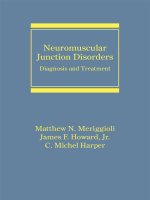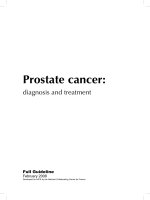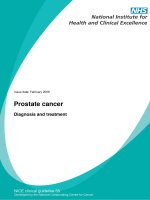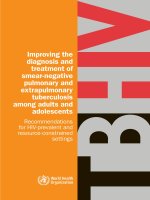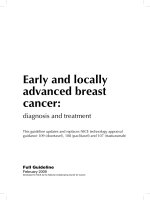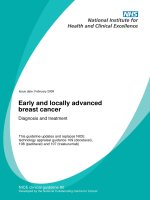EARLY DIAGNOSIS AND ADEQUATE TREATMENT
Bạn đang xem bản rút gọn của tài liệu. Xem và tải ngay bản đầy đủ của tài liệu tại đây (1.61 MB, 9 trang )
EARLY DIAGNOSIS AND
ADEQUATE TREATMENT
in
THE NEUROGENIC BLADDER
NGUYỄN ĐÌNH THÁI
KHOA NIỆU
BV NHI ĐỒNG 2
Introduction
Neurogenic bladder sphincter dysfunction (NBSD):
result of a lesion at any level in the nervous system
From congenital neural tube defects
(myelomeningocele, spina bifida, …) / acquired
causes (tumor, trauma).
Disordered innervation of the detrusor
musculature and external sphincter.
Untreated: incontinence, secondary damage
and dysfunction upper and lower urinary tracts.
Pathophysiology
disordered innervation of the detrusor
musculature and external sphincter
detrusor external sphincter dyssynergia
increase intravesical pressure (>40 cm H2O)
Upper/ lower urinary tract deterioration.
Management
Treatment goals:
prevent or minimize secondary damage to the
upper urinary tracts and bladder
achieve safe social continence
Optimal management:
Early diagnosis & recognition of high-risk subtypes
(urodynamic)
Proactive therapy:
Clean intermittent catheterization (CIC)
Anticholinergics (oxybutynin)
Management
Evidence based
Am J Dis Child. 1992: Kasabian, Children's Hospital,
Boston
The prophylactic value of clean intermittent
catheterization and anticholinergic medication in
newborns and infants with myelodysplasia at risk of
developing urinary tract deterioration
After 5 years follow up:
24 (92%) / 26 children had normal kidney function and
drainage
2 (8%) developed hydroureteronephrosis
1 had vesicoureteral reflux
Control group: upper urinary tract had changed in 48%
Evidence based
J Urol. 1999: Kaefer, Children's Hospital, Harvard
Medical School, Boston.
Improved bladder function after prophylactic treatment of
the high risk neurogenic bladder in newborns with
myelomentingocele.
After 4 years follow up:
3 (17%)/ 18 children treated prophylactically required
enterocystoplasty
11 (41%)/ 27 children treated expectantly required
augmentation
Evidence based
Neurourol Urodyn. 2006: Kessler, University Hospital
Innsbruck, Austria
Early proactive management improves upper urinary tract
function and reduces the need for surgery in patients with
myelomeningocele.
Initial evaluation & medical treatment:
day of birth to age 2: 15% required surgical interventions
age 3 to age 10: 34%
after age 10: 59%
initiation of proactive neurourological management as
early as possible, ideally from the day of birth, is strongly
recommended
Conclusions
Medical management (CIC and anticholinergics):
preserving renal function and providing safe
urinary continence in more than 90% of patients
with a neurogenic bladder.
Early diagnosis and adequate treatment (long
before toddler age) prevent: renal damage &
secondary bladder wall changes no longer
need surgical bladder augmentation to achieve
safe urinary continence in adolescence and
adulthood.

